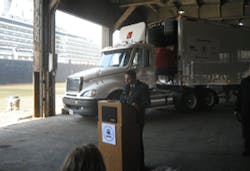NEW YORK. To show that it pays to be green, the U.S. EPA along with its state and private partners yesterday held a reefer unit “plugging in” to eliminate the idling of reefers at Pier 92 of the New York Cruise Terminal. The pilot program, started by a $100,000 EPA grant, is focused on stopping idling at two major sources: ports and reefer trucks.
The pilot is centered around the operations of Maines Paper & Food Service Inc., a food distributor. The company equipped ten of its port-routed trailers with Carrier Vector 1800 MT reefers—hybrid units that run on either a 2.2-liter diesel engine or electricity. The trailers equipped with hybrid reefers operate out of Maines’s primary facility in Cronklin, NY.
The Vector 1800 MT is powered by a 2.2-liter diesel engine when going over the road, and when parked it can either continue to run off the diesel engine or be shut down and run off of electricity.
Parked trucks plugging into an electrical terminal provided by Shurepower, one of the partners in the EPA pilot, incur a nominal hourly fee of $1. At the event Shurepower plugged the back of the trailer into the electrical terminal to power the reefer unit.
The up-charge on each Vector 1800 MT unit compared to one without an “electric standby” option is estimated to be $3,000, according to Carrier officials. Maines director of transportation Jeff David said the company realized a one-year return on investment for its port-bound trucks.
“We saw expenses drop dramatically for those units,” David told FleetOwner.
EPA’s $100,000 grant was managed by the New York State Energy and Research Development Authority (NYSERDA).
“The ports are pretty well squared away as far as having electrification infrastructure,” Joseph Tario, NYSERDA senior project manager of transportation and power systems research told FleetOwner. “[The power] is also commonly available in big industrial areas such as warehouses and grocery chains with their own facilities.”
However, the cost to install the electrification terminals is significant, especially given the high price of copper, but the potential savings at facilities that receive a lot of reefer traffic is high, Tario said.
Speaking at the event, EPA regional administrator Alan Steinberg emphasized that electrification at the ports presents enormous clean air potential while providing reefer trucking companies with an economical alternative to burning diesel fuel when parked.
“The future of port commerce will involve more connections with the [electric] grid,” said Steinberg.
To comment on this article, write to Terrence Nguyen at [email protected]
